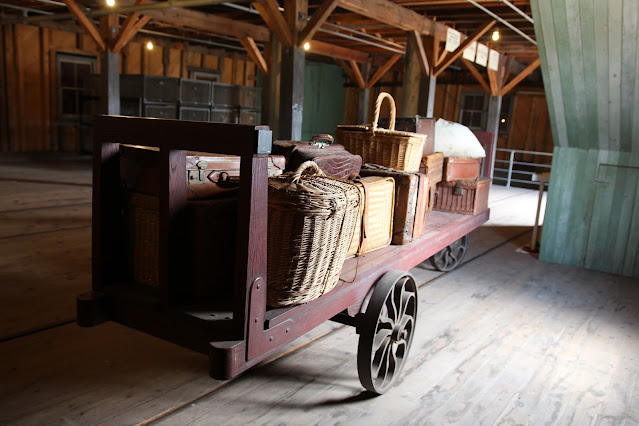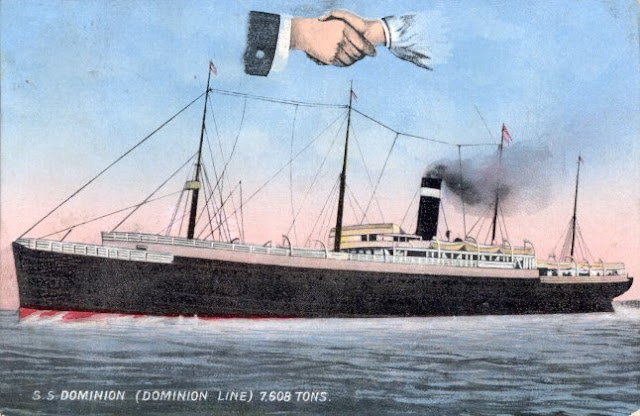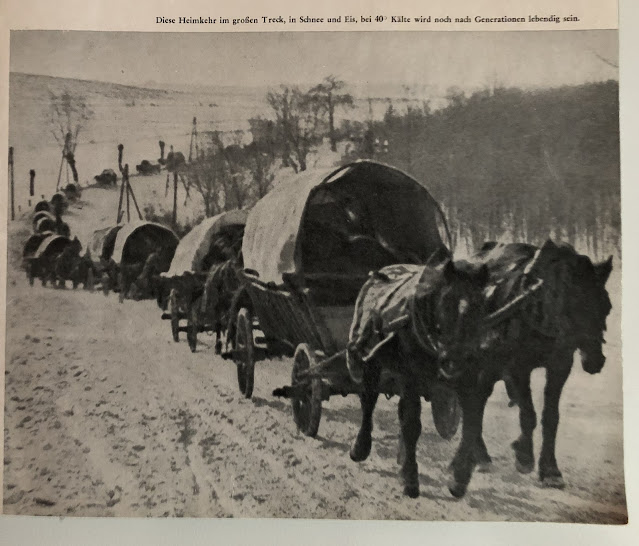In honour of Remembrance Day I’d like to share the story and commemorate the service of my 6x great grandfather, a career soldier and United Empire Loyalist.
Hugh McKay was born around 1735, somewhere in Scotland. I have yet to determine where. As a young man he followed in the footsteps of many others and joined the British army, probably around 1758. According to one of his wife’s later Land Petitions he “faithfully served His Majesty George the Third as a paymaster sergeant in the 8th regiment of infantry for the space of 18 years”. The records of the 8th regiment of Foot are available at the National Archives at Kew in London and I hope to be able to see them one day, though details on enlisted men are often not
extensive.
_-_Grenadiers,_7th_Royal_Fusiliers,_8th_King's_and_9th_Regiments_of_Foot,_1751_-_RCIN_405580_-_Royal_Collection.jpg) |
| Uniform of King's Regiment (centre) David Morier Collection, Wikimedia Commons |
_Regiment_of_Foot_Badge.jpeg) |
| Historical Record of the Eigth, or the King's Regiment of Foot Wikimedia Commons |
The 8th, or “King’s”, Regiment of Foot was one of the most senior regiments, originally raised in 1685. During the Seven Years War (1756-63) the 8th was involved in some raids on the French coast in 1757-58. Later it fought in battles in Germany in 1760-62, including the Battle of Warburg on 31 July 1760, the Battle of Vellinghausen on 15 July 1761, and the battle that ended the Seven Years War in Europe, the Battle of Wilhelmstahl on 24 June 1762.
At this point Hugh and the 8th would have returned to England and Hugh began his family life. Around this time Hugh and Mary Embling were married. I know very little about Mary who was born around 1743. My 5x great grandmother Elizabeth was born around 1763 so presumably the couple was married at some point before this date. Hugh must have been stationed away from Mary (or perhaps some children died in infancy) as the next birth I could document was six years later. At this point the McKays were in Canada. The 8th landed on Île D’Orleans in the summer of 1768 and was then deployed to surrounding posts.
According to A Military History of Quebec it was customary for soldiers wishing to marry to seek permission from their commanding officers. If granted, dependents were then entitled to quarters and rations. When a regiment left the UK for overseas only a limited number of wives were entitled to accompany them, be borne on regimental strength and receive rations from the government. The general ratio was 6 wives for every 100 men but this was often broken. Either way, Mary and Elizabeth were granted permission to travel with Hugh to Canada.
Hugh was likely stationed with the 8th at Fort Oswegatchie (now Ogdensburg in upper New York State). It was from here that Captain George Forster led a force of 40 regulars and 200 Indigenous warriors across the St Lawrence to attack Fort Cedars, just outside Montreal. This post was held by the Americans, who had invaded Canada in 1775 under the leadership of Benedict Arnold. The British were victorious in the battle (actually a series of skirmishes) that took place between May 18 and 27 1776. The Americans subsequently withdrew from Quebec.
 |
| Bibliothèque Nationale de France from Wikimedia Commons. The Cedars are in the lower left of map |
The regiment’s next engagement was the siege of Fort Stanwix in August 1777. Hugh was also involved in the Battle of Orskany on 6 August 1777, fighting alongside Sir John Johnson’s King’s Royal Regiment of New York. According to a later memorial:
… his conduct in a Temporary Station under the Command of Major Forster(a Vollantier [sic]) on an Expedition against the Rebels at the Cedars; and soon after a second Time a Vollantier with Sir John Johnson on his first coming into Canada, was such as gained him the particular Notice of these brave Officers, and by whose Recommendation he obtained his Discharge
Shortly afterwards he obtained his first Assistant Commissary position at Isle aux Noix, in the Richelieu River. Returns of Provisions Condemned by Survey at Isle Aux Noix refers to the “time of Mr. McKay” prior to May 1778.
 |
| Haldimand Papers, Contingent and Current Accounts Relating to the Commissariat 1767-1782 |
By October 1778 Hugh and his family had relocated to Carleton Island where Hugh was appointed Assistant Commissary and acting Barrack Master. Carleton Island is located in the middle of the St Lawrence River between New York and Ontario and was named after Sir Guy Carleton. The island became a base for British ships and construction of a fort was begun, though never completed. During the McKay’s stay over 1000 merchants, camp followers, soldiers, sailors and displaced Loyalists were living on the island which fell under the command of Sir Frederick Haldimand, “Captain General and Governor in Chief in and over our province of Quebec in America”.
 |
| Plan of Carleton Island by A. Gray Asst Qr Mr Genl Quebec 29 Dec 1810 Wikimedia Commons |
Sir Frederick Haldimand produced a voluminous quantity of correspondence that is housed in manuscript form in the British Library. Library and Archives Canada have a copy of the material which is digitized on heritage.canadiana.ca. In his role as Captain General he was closely involved in the running of the various military bases, including Carleton Island. It’s amazing that a man with his responsibilities was so on top of the minutiae of day of day operations. His papers have proved a treasure trove of information on Hugh McKay’s trials and tribulations in his activities after his army service.
Hugh and Mary’s family had grown: Anne born in 1769, Deborah born in 1770, Mary born in 1775, Isabella born in 1777, Jane born in 1779 and Bridget born 1780. Church records for the baptisms of the children are unavailable as the military chaplain records are lost. Many a family historian has tried to locate but to no avail.
Shortly after his arrival at Carleton Island Hugh encountered difficulties and his woes are well documented in the Haldimand papers. It appears that Mary McKay had requested and received permission to run a small business to supplement Hugh’s earnings of five shillings a day, an amount that was not adequate to support a family of nine.
In a Memorial to Haldimand Hugh stated that the family arrived at Carleton Island 22 October 1778. There was no place to live and nothing was provided for him. He had to build at a very great expense, a place to live:
But by the Industry of my wife and daughter, who carry’d on a small trade in dry goods in which I had no connection, I have been able to support my wife and seven children
The family carried on until April 1780 when disaster struck - General Haldimand was informed that Hugh was engaged in trade and determined to discourage this practice, removed him from his post. Hugh was devastated and spent the next few years protesting his innocence and requesting reinstatement and vindication. He relocated his family to Quebec City where he continued to contact Haldimand. On 19 December 1782 he wrote to Haldimand:
… some time after Totally dismiss’d His Majesty’s Service, without giving your Memorialist an opportunity of Vindicating his Conduct (which Indulgence has been doubly granted to one, who never Served His Majesty in any other, and of less standing in that Department) was uncommon to one whose long and faithfull Services Justly intitled him to
Hugh felt he had discharged his duty in the strictness manner, settled the last ounce of provisions, but in the process gained enemies. He felt he had borne an “unblemished character through life, both as a man, and a soldier” and demanded a Board of Inquiry review his case.
It took until the following December for a Board to be arranged to review Hugh’s case. In a March 1784 memorial Hugh shares his good news to General Haldimand. The Board of Inquiry could not find “the last vestige of that fraud which calumny had suggested”. His character had been reinstated, but “his misery has not been removed”. His family still depends on him, though “now in an advanced period of life unable to act with that vigour and activity he has so faithfully exhausted and spent in the Service of his King and Country”.
Hugh sought pay from the time of his dismissal until 24 December 1783 when a reduction in every department took place, based on Haldimand’s 24 April 1780 letter promising a continuation of his pay. He had received payment for the provisions taken from him 2 years ago but he sustained a loss as the property was undervalued at £8.19.5, a loss he cannot sustain, as the money went directly into the hands of his creditors.
 |
| Haldimand Papers Hugh McKay 19 December 1782 Memorial |
It is interesting to note that in 1781 there is mention that the above provisions were transferred from the Kings Store to Mr. Thompson, the Shop keepers house. This would appear to be Archibald Thompson who shortly marry Hugh’s daughter Elizabeth.
As it was not possible to be reinstated into his former position, Hugh asked that he receive his share of land based on his last military service in Sir John Johnson’s Corps. His petitions were unsuccessful, but by this time Hugh had established himself in Quebec City, rising to a new level of respectability and success. Stay tuned for part 2 of his story.












































